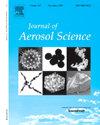Process design for gas-phase synthesis of iron nanoparticles from iron pentacarbonyl
IF 3.9
3区 环境科学与生态学
Q2 ENGINEERING, CHEMICAL
引用次数: 0
Abstract
Gas-phase synthesis of iron nanoparticles (Fe NPs) by thermal decomposition of iron pentacarbonyl, , is simulated using a simple particle dynamics model coupled with gas-phase chemistry. The performance of a detailed chemical kinetics model for the decomposition of is compared with that of a global decomposition rate. The particle dynamics model interfaces with gas-phase chemistry through particle inception and surface growth. Using the size-dependent melting temperature of primary particles (PP), the available characteristic sintering time, , for Fe NPs is modified and its performance in predicting PP diameter, , is benchmarked with literature data. The modified significantly enhances the prediction of and agglomerate morphology, highlighting the importance of sintering during high temperature synthesis of Fe NPs. Diagrams for the degree of hard-agglomeration are developed in terms of the reactor initial precursor concentration, maximum temperature, cooling rate, and particle residence time. The results of the PP size of Fe agglomerates are compared with TEM measurements available in the literature for the synthesis of Fe NPs. The model predictions are in good agreement with the measured and concentration of Fe NPs produced by thermal decomposition of .

五羰基铁气相合成纳米铁的工艺设计
采用结合气相化学的简单颗粒动力学模型,模拟了五羰基铁Fe(CO)5热分解气相合成铁纳米颗粒(Fe NPs)的过程。将Fe(CO)5分解的详细化学动力学模型的性能与全局分解速率模型进行了比较。粒子动力学模型通过粒子起始和表面生长与气相化学相结合。利用初生颗粒(PP)的尺寸相关熔化温度,修正了Fe NPs的可用特征烧结时间τs,并用文献数据对其预测PP直径dp的性能进行了基准测试。修正后的τs显著增强了对dp和团聚体形貌的预测,突出了烧结在高温合成铁纳米粒子过程中的重要性。根据反应器初始前驱体浓度、最高温度、冷却速率和颗粒停留时间,绘制了硬团聚程度图。铁团块的PP尺寸的结果与文献中可用的铁NPs合成的TEM测量结果进行了比较。模型预测结果与实测的dp和由Fe(CO)5热分解产生的Fe NPs浓度吻合较好。
本文章由计算机程序翻译,如有差异,请以英文原文为准。
求助全文
约1分钟内获得全文
求助全文
来源期刊

Journal of Aerosol Science
环境科学-工程:化工
CiteScore
8.80
自引率
8.90%
发文量
127
审稿时长
35 days
期刊介绍:
Founded in 1970, the Journal of Aerosol Science considers itself the prime vehicle for the publication of original work as well as reviews related to fundamental and applied aerosol research, as well as aerosol instrumentation. Its content is directed at scientists working in engineering disciplines, as well as physics, chemistry, and environmental sciences.
The editors welcome submissions of papers describing recent experimental, numerical, and theoretical research related to the following topics:
1. Fundamental Aerosol Science.
2. Applied Aerosol Science.
3. Instrumentation & Measurement Methods.
 求助内容:
求助内容: 应助结果提醒方式:
应助结果提醒方式:


